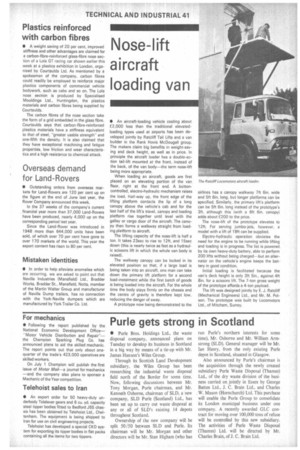Nose-lift aircraft loading van
Page 43

If you've noticed an error in this article please click here to report it so we can fix it.
• An aircraft-loading vehicle costing about £2,000 less than the traditional elevatedloading types used at airports has been developed jointly by Ratcliff Tail Lifts and a van builder in the Rank Hovis McDougall group. The makers claim big benefits in weight-saving and deck height, as well as in price. In principle the aircraft loader has a double-action tail-lift mounted at the front, instead of the back, of the van body—the term nose-lift being more appropriate.
When loading an aircraft, goods are first placed on an elevating portion of the van floor, right at the front end. A buttoncontrolled, electro-hydraulic mechanism raises the load. Half-way up, the front edge of the lifting platform contacts the lip of a long canopy above the vehicle's cab and for the last half of the lift's travel, canopy and loading platform rise together until level with the galley or cargo door of the aircraft. The canopy then forms a walkway straight from loading platform to aircraft.
The lifting capacity of the nose-lift is half a ton. It takes 23sec to rise to 12ft, and 15sec down (this is nearly twice as fast as a hydraulic scissors lift in which the whole van body is raised).
The walkway canopy can be locked in its elevated position so that, if a large load is being taken into an aircraft, one man can take down the primary lift platform for a second load-instalment while the first batch of goods is being loaded into the aircraft. For the whole time the body stays firmly on the chassis and the centre of gravity is therefore kept low, reducing the danger of sway.
A prototype now being demonstrated to the airlines has a canopy walkway 7ft 6in, wide and 5ft 6in. long, but longer platforms can be specified. Similarly, the primary lift's platform can be 5ft 6in, long instead of the prototype's 3ft, although this (with a 6ft 6in. canopy) adds about £200 to the price.
The nose-lift of the prototype elevates to 12ft. For serving jumbo-jets, however, a model with a lift of 18ft can be supplied.
Electra-hydraulic operation obviates the need for the engine to be running while lifting and loading is in progress. The list is powered by its Own heavy-duty battery, able to perform 200 lifts without being charged---but an alternator on the vehicle's engine keeps the battery in good condition.
Initial loading is facilitated because the van's deck height is only 3ft 5in., against 4ft 8in. for a scissors lift. The 7-ton gross weight of the prototype affords a 4-ton payload.
The lift was designed jointly by E J. Ratcliff (Mechanical Engineers) Ltd., and Mr. M. Poison. The prototype was built by Locomotors Ltd., of Mitcham, Surrey.


















































































































